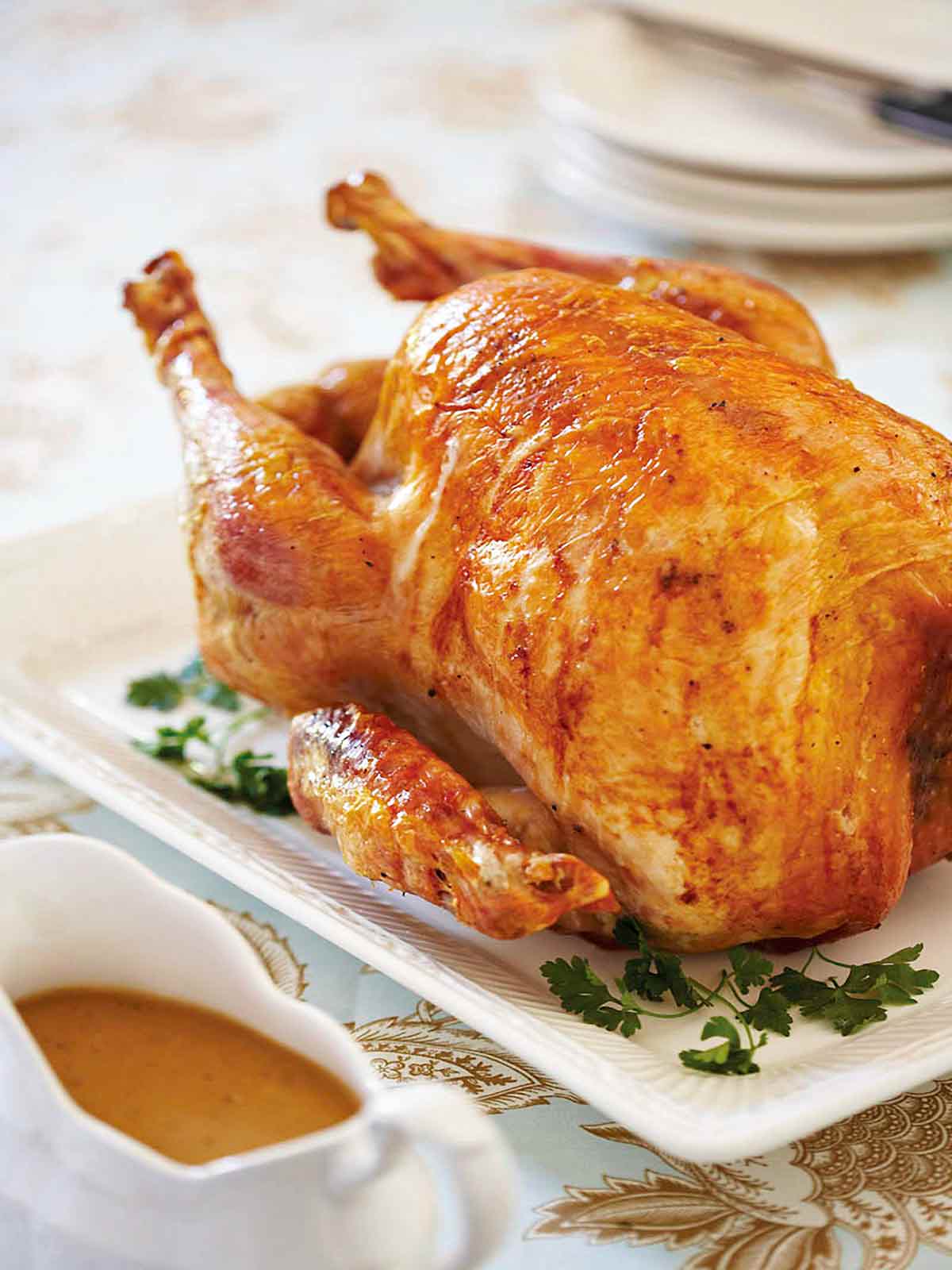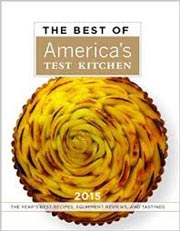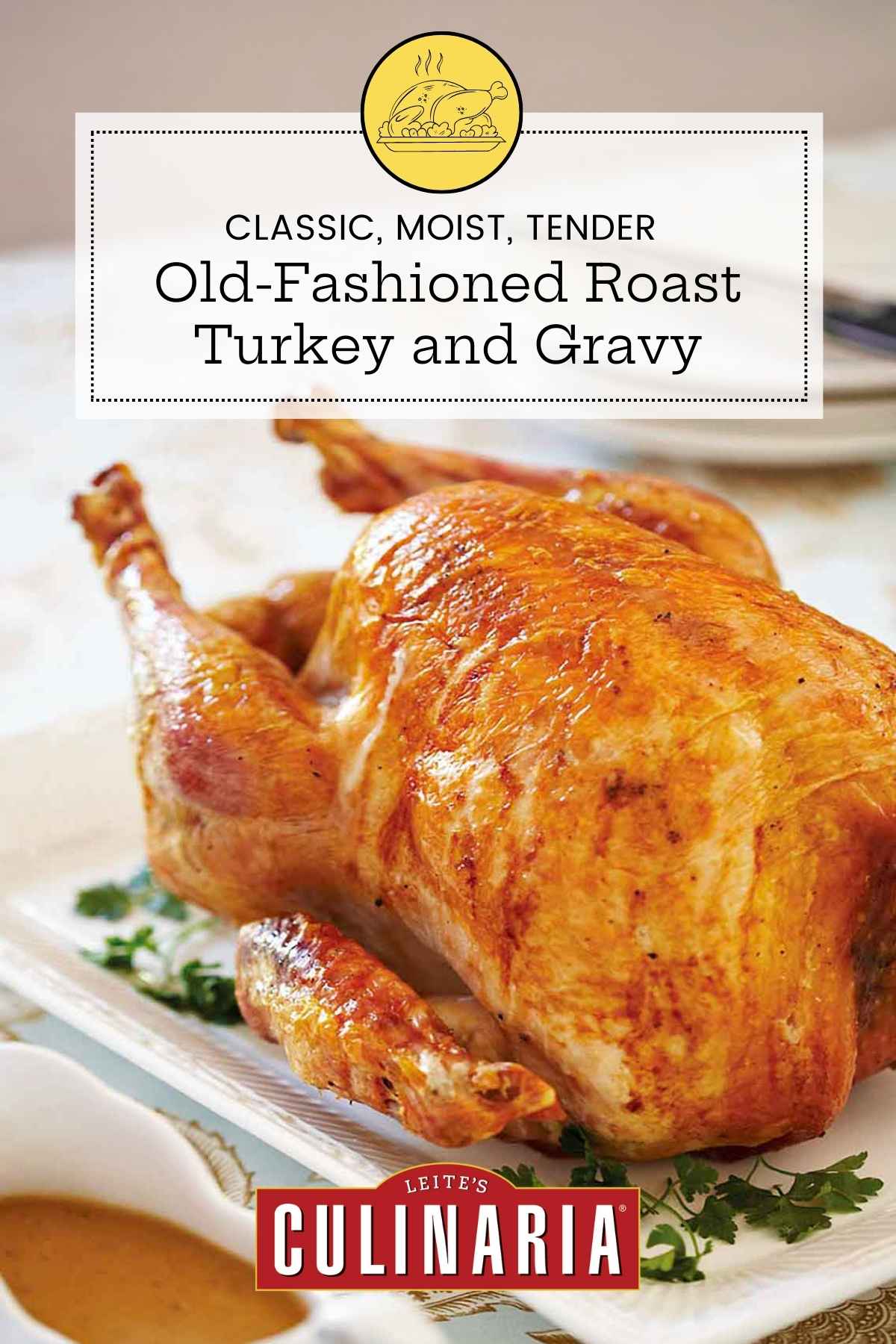
This old-fashioned roast turkey and gravy reminds us why there’s a lot to be said for old-fashioned. Like cheesecloth draped on a roast turkey to guarantee shatteringly crisp skin. That’s because it works. So we’re not averse to old-fashioned. Not at all.–Renee Schettler Rossi

Old-Fashioned Roast Turkey and Gravy
Video
Equipment
- Cheesecloth
Ingredients
For the turkey
- 4 cups cold water
- One (12- to 14-pound) turkey, neck and giblets reserved
- 1 pound salt pork, cut into 1/4-inch-thick (6 mm) slices
For the gravy
- 1 tablespoon mild vegetable oil
- Reserved turkey neck and giblets
- 1 5 oz onion, diced
- 5 cups cold water
- 2 cups homemade chicken stock or low-sodium canned chicken broth
- 4 sprigs fresh thyme
- 1 bay leaf
- 4 to 6 tablespoons unbleached all-purpose flour
- Salt and freshly ground black pepper
Instructions
Roast the turkey
- Preheat the oven to 350°F (175°C) and adjust an oven rack to the lowest position. Fold the cheesecloth into an 18-inch square, place it in a large bowl, and cover it with the water.
- Arrange the turkey, breast-side up, on a V-rack set inside a roasting pan and tuck the wings behind the back of the turkey. Prick the skin of the breast and legs of the turkey all over with a fork, cover the breast and legs of the turkey with the salt pork, top with the soaked cheesecloth, and pour any remaining water into the roasting pan. Cover the cheesecloth completely with heavy-duty aluminum foil.
- Roast the turkey until the thickest part of the breast registers 140°F (60°C) on an instant-read thermometer, 2 1/2 to 3 hours.
- Remove the foil, cheesecloth, and salt pork and discard. Increase the oven temperature to 425°F (220°C). Continue to roast until the thickest part of the breast registers 160 to 165°F (71°C), 30 to 45 minutes longer.
- Transfer the turkey to a cutting board and let rest for 30 minutes. Reserve the roasting pan.
Make the stock for the gravy
- While the turkey is roasting, heat the oil in a large saucepan over medium-high heat until it shimmers. Add the turkey neck and giblets and cook, stirring, until browned, about 5 minutes.
- Add the onion and cook until softened, 5 to 7 minutes.
- Stir in the water, stock or broth, thyme, and bay leaf and bring to a boil. Reduce the heat to low and gently simmer, skimming and discarding any scum that rises to the surface, until the stock is reduced by half, about 3 hours.
- Strain the stock, reserving the giblets, if desired. You should have about 3 1/2 cups stock.
Make the gravy
- Pour the liquid from the roasting pan into a strainer and then pour them into a fat separator. Let the juices and fat separate.
- Skim the fat from the surface of the strained juices, reserving about 1/4 cup fat in a small bowl.
- Pour the defatted pan juices into the measuring cup along with enough of the stock to measure 4 cups.
- Heat the reserved fat in a saucepan over medium heat until it shimmers. Stir in the flour and cook until it’s honey-colored and fragrant, about 4 minutes.
- Slowly whisk in the stock and bring to a boil. Reduce the heat to medium-low and simmer, stirring frequently, until the gravy is slightly thickened, 5 to 10 minutes.
- If desired, chop the giblets and add them to the gravy. Season with salt and pepper to taste.
- Carve the turkey and serve it with the gravy.

Explore More with AI
Nutrition
Nutrition information is automatically calculated, so should only be used as an approximation.
Recipe Testers’ Reviews
If you’re looking for a super simple way to cook a flavorful turkey, this is the recipe for you. There’s no stuffing, basting, seasoning, brining, or trussing involved!
Since I was making this in August, I was only able to find a 19.8-pound frozen turkey. I purchased it a week before I planned to serve the meal and let it thaw in the fridge. I’ve seen a lot of comments referencing increased cooking times for larger birds but my turkey did not take significantly longer to cook than the recipe states. The first roast was 3 hours, then after removing the salt pork/cheese cloth, the turkey roasted another 45 minutes before reaching an internal temperature of 160°F. Because the turkey is neither stuffed nor trussed, the air can circulate in, through, and around the bird for more expedited cooking.
I always let my roasts rest 30 minutes to an hour. This began as a necessity, as I have only one oven, and the sides went in when the turkey came out, but we quickly figured out that the bird is just juicier if left alone for longer. This cooking technique resulted in a well-seasoned, beautifully browned, perfectly cooked, moist turkey with really minimal effort. I’ll definitely be making this again for my entire family in November.
The idea of starting the gravy once you put the bird in the oven is brilliant. However, I have a few suggestions. After the requisite 3 hours, I was left with only 2 cups of stock, which I supplemented with the ample defatted pan juices to equal almost 4 cups. (The sheer volume of pan juices with this recipe was enough to make me dance around the kitchen.)
With the chopped giblets, this gravy was outstanding and I’ll continue using this recipe with my adjustments in the future as it created a delicious, deeply flavored, and satisfying gravy my entire family loved.”
If you’re looking for a foolproof recipe for turkey, this is it! I have tried every method over the years for roasting turkeys, and while there are many good ways, this one is quite easy and guaranteed to give you tender, juicy, evenly cooked meat (both the dark and white) without having to baste.
The salt pork bastes, flavors, and prevents the meat from overcooking and drying out. The texture of the meat was just perfect. Removing the salt pork, cheesecloth, and foil for the final half hour or so of roasting gave the skin the perfect color and crispness. One addition I would make would be to salt and pepper the inside cavity of the bird, as I thought the meat could use a little extra seasoning.
Notes: The active time was approximately 1 1/2 hours and the total time was almost 5 hours. I used a 15-pound turkey, so it took a bit longer to cook. Generally, the timing throughout the recipe was very accurate. The pan drippings were quite fatty and took a while to separate. The gravy took more like 10 minutes to thicken, but it was delicious. I didn’t use the giblets, but did use the meat from the neck chopped finely, which was very flavorful. Also, I would salt and pepper the inside cavity of the bird even though the recipe doesn’t call for it.
You will easily get 10 to 12 servings from this recipe.













Hello! Would you help me adapt this recipe for turkey breasts? My family prefers white meat. I’m also wondering how many breasts (and weight of breasts) I should buy if I’m cooking for 15. Thanks so much!
Wendy, I’d suggest using this recipe for turkey breasts. You may need to increase the amount of turkey by a pound or two to feed 15 people, but this will give you a method specifically designed for turkey breasts. If you want to make gravy, you can follow the recipe for the gravy in this post, or we have a basic pan gravy recipe that will work well with the drippings from your turkey breasts.
Can I use this recipe if I am going to stuff my turkey? If so does how will the cooking time change?
Hi Maureen, generally speaking, stuffing a bird can add up to an hour of cook time. It is best to use a thermometer to ensure that the bird and the stuffing reaches a target temp of 165 degrees.
Got a question: Can I substitute unsalted butter for the salt pork and get the same result? (It’s a dietary thing…)
Dorothy, no, alas, that won’t work. The reason is the pound of salt pork will slowly render, keeping the turkey moist and season it. A pound of butter would sluice right off. We do have other Thanksgiving turkey recipes that don’t use pork.
I see… I’d sure love to try this but, I won’t be able to but I hope everyone else does because it sounds excellent!!
So sorry, Dorothy…